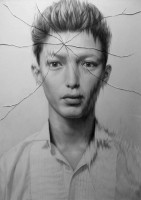TAISUKE MOHRI
泰介毛利
source: designboom
‘cracked portraits’ by japanese designer taisuke mohri are a series of detailed pencil artworks overlayed with a pane of cracked glass –
known as the ‘material cracks’. the confronting work, to be shown at frantic gallery in tokyo, errs on the edge of something existent in reality and something imagined – offered only by the precise hyper-real workmanship – where the audience is asked to take a moment to understand and absorb what they are viewing.
the delicate pencil studies, often representing young boys or older men, are disrupted by severe veins of fractured glass, helping the viewer to distinguish what is real and what is artificial. the portraits are reminiscent of a face behind a window on a rainy day, accented with moments in the image depicted by smeared pencil work. the work itself is a visual/psychotic inquiry into the unattainable dance of the sincere and illusive, confusing the ways we perceive the present and actuality.
.
.
.
.
.
.
source: tartestudio
Una de las características principales del arte es su capacidad para discernir la separación entre lo representado en la imagen y su existencia en la realidad. El espectador enseguida se da cuenta de que la imagen a la que se enfrenta no es real, sino una obra de arte que el artista ha querido plasmar. Sin embargo, en los “retratos agrietados” de Taisuke Mohri, la materia traiciona al espectador y participa de la ilusión de la obra artística y se convierten así en cómplice de la simulación. Estos retratos hiperrealistas creados a lápiz llevan encima una lámina de cristal agrietada, segmentando la imagen en trozos más o menos borrosos. Las grietas se convierten así en parte de la imagen, creando líneas en el propio cuadro.
Estos “retratos agrietados” se pueden ver actualmente en la galería Frantic de Tokio, donde se representan tanto a jóvenes como ancianos, con una precisión extrema en los detalles. Si bien la representación es real y obtiene una presencia física, el contenido se dirige hacia la simulación y el reino de lo imaginario, confundiendo la forma en la que percibimos el presente y la realidad.


